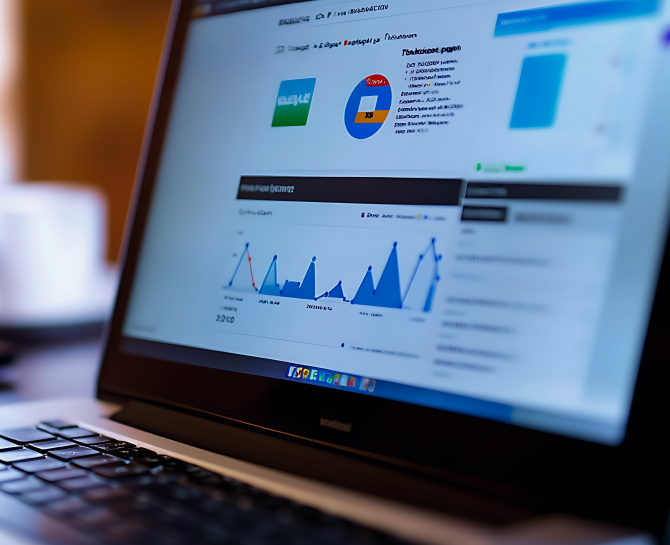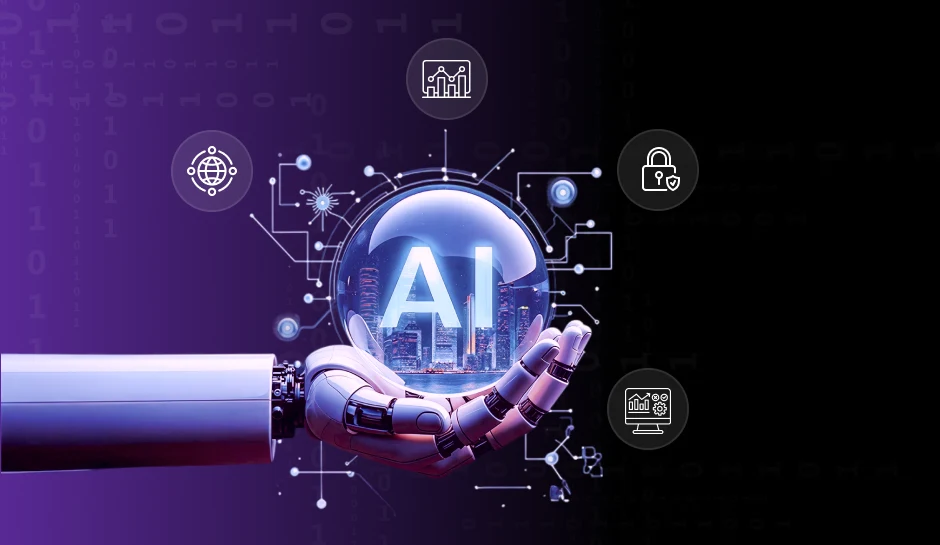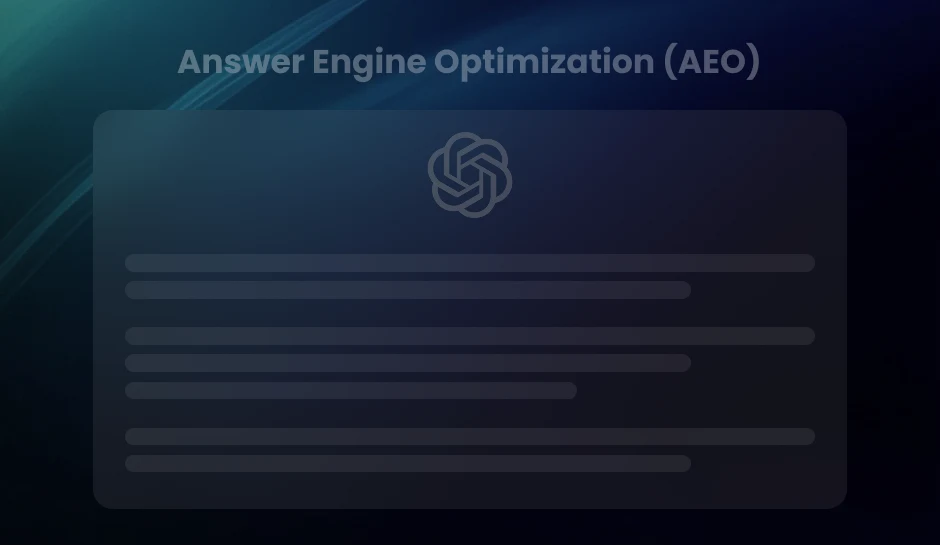
Google Analytics AI: How Businesses Can Automate Data Analysis in 2025
Businesses are shifting from manual data analysis to AI-powered insights. Google Analytics AI not only tracks website activity but also predicts future trends, helping companies refine marketing strategies and optimize customer engagement.
Businesses are no longer just collecting data. They are competing on how well they use it. In 2025, Google Analytics AI is not just generating reports but is actively influencing business decisions. Companies that manually analyze data are falling behind, while those leveraging AI are predicting trends, automating workflows, and optimizing marketing strategies in real time.
What has changed:
Google Analytics AI has evolved beyond basic automation. It is now an autonomous system that detects revenue leaks, identifies conversion opportunities, and forecasts customer behavior before it happens. Businesses that integrate these AI-driven insights are reducing costs, improving customer experience, and increasing profitability.
This blog will explore how businesses can fully automate data analysis with Google Analytics AI, uncovering advanced features, hidden tracking capabilities, and strategies to gain a competitive edge. It will also highlight the limitations, biases, and risks of over-relying on AI for business decisions.
Google Analytics AI in 2025: How It Has Evolved
Google Analytics AI has transformed significantly, shifting from a reactive data reporting tool to a proactive intelligence system that predicts customer behavior, automates decision-making, and integrates insights across multiple touchpoints.
Unlike its earlier versions, which primarily analyzed past interactions, Google Analytics AI in 2025 enables businesses to anticipate user actions and optimize strategies in real time. By leveraging AI-driven recommendations, companies can reduce manual effort and focus on execution rather than analysis.
Beyond website tracking, Google Analytics AI now integrates with mobile apps, customer relationship management (CRM) systems, AI chatbots, call centers, and even IoT devices. This seamless data connectivity allows businesses to build a unified view of their customers, enabling hyper-personalized marketing strategies and improved customer experiences.
Another major advancement is the introduction of more granular AI models tailored to specific industries. eCommerce businesses benefit from AI-driven product recommendations and cart abandonment predictions, SaaS companies gain insights into churn risks and user engagement, and B2B firms can analyze long sales cycles and account-based marketing performance.
By evolving into an industry-specific and predictive analytics platform, Google Analytics AI in 2025 provides businesses with actionable insights that drive smarter, faster, and more strategic decision-making.
What Google Analytics AI Tracks That You Do Not Realize
Most businesses focus on standard metrics such as traffic, bounce rates, and conversions. However, Google Analytics AI goes beyond basic reporting. It tracks hidden patterns that provide deeper insights into user behavior. Understanding these unseen signals can help businesses optimize their strategies and improve decision-making.
How Google’s AI Understands Your Business Better Than You Do
Google Analytics AI continuously analyzes vast datasets to detect trends and predict user actions. It identifies patterns that are not immediately visible, allowing businesses to anticipate customer needs and take proactive measures.
Hidden Tracking Factors
- Tracking Micro-Interactions:
- Identifying User Frustration Signals:
- Analyzing Near-Conversion Moments:
Google Analytics AI tracks small actions such as hesitation before clicking, repeated scrolling, or hovering over specific elements. These signals indicate user intent and potential engagement.
Rapid scrolling, rage clicks, and repeated form submissions suggest a poor user experience. AI detects these patterns and helps businesses identify areas that need improvement.
AI analyzes users who abandon their journey at the final stage of a conversion process. Understanding these behaviors helps businesses optimize the customer journey and recover lost conversions.
Case Study: How DiGGrowth Helped a Renowned E-Commerce Business Achieve an 18 Percent Increase in Conversions
The Problem: High Cart Abandonment and Unclear Drop-Off Reasons
A leading eCommerce company struggled with a high cart abandonment rate. Despite having competitive pricing and a smooth checkout process, a significant percentage of users exited just before completing their purchases. Traditional analytics provided basic insights, such as exit rates and session durations, but failed to reveal why users were dropping off at the final stage.
The Solution: Leveraging Google Analytics AI for Micro-Conversion Analysis
The company integrated Google Analytics AI through DiGGrowth to conduct a deep behavioral analysis of user interactions. Instead of just tracking completed transactions, the AI-powered system:
- Analyzed micro-interactions:
- Identified frustration signals:
- Predicted abandonment risks:
Detected users who hesitated on the checkout page for more than five seconds.
Tracked repeated cursor movements, indecisiveness in clicking, and instances where users removed and re-added items to their carts.
Flagged users who scrolled back to product descriptions or left the checkout page to explore discount-related pages.
Using these insights, DiGGrowth implemented an AI-driven personalized intervention strategy. The company introduced a limited-time discount pop-up, which appeared only for users who showed hesitation patterns. This strategy aimed to nudge uncertain buyers into completing their purchases without affecting overall pricing perception.
The Results: 18 Percent Increase in Conversions and Improved Checkout Experience
Within six weeks of implementing the AI-driven strategy, the company achieved:
- 18 percent increase in conversion rates by targeting hesitant buyers with personalized discount pop-ups.
- Reduced cart abandonment rates as users who initially hesitated were encouraged to complete their purchases.
- Optimized customer experience by identifying unnecessary friction points in the checkout process.
Smart Features of Google Analytics AI
AI-Powered Insights: Data Interpretation at Scale
Google Analytics AI delivers advanced insights by processing vast amounts of user data and identifying emerging trends. Instead of manually sifting through reports, businesses receive automated recommendations on user behavior, conversion patterns, and content performance.
- Trend Detection:
- Anomaly Identification:
- Correlative Analysis:
The system identifies significant changes in user engagement and flags them as insights.
Unusual spikes or drops in metrics trigger insights that highlight possible causes.
AI uncovers hidden relationships within metrics, linking user actions to conversion outcomes.
These insights reduce the time spent on data analysis, allowing teams to focus on strategy and execution.
Machine Learning and Predictive Analytics
Google Analytics AI employs machine learning models to predict future performance metrics. By analyzing historical data, it forecasts trends in user behavior and business outcomes.
- Purchase Probability:
- Churn Probability:
- Revenue Predictions:
Identifies users who are most likely to complete a transaction.
Flags users at risk of disengaging so targeted retention strategies can be applied.
Estimates potential revenue from specific user segments, guiding budget allocation.
These predictive insights enhance decision-making by enabling proactive marketing adjustments.
Automated Insights: Instant Reporting Without Manual Input
Google Analytics AI continuously scans data and autonomously surfaces critical findings. Rather than relying on manual queries, businesses receive real-time notifications about significant developments.
- Traffic Anomalies:
- Top-Performing Content:
- Acquisition Trends:
Unexpected increases or decreases in traffic get flagged instantly.
Identifies pages and assets driving the highest engagement.
Shows shifts in traffic sources, highlighting new opportunities for growth.
With automated insights, teams no longer need to deep-dive into reports to detect patterns—the system delivers key takeaways directly.
Advanced AI Features in Google Analytics You Are Probably Not Using
Google Analytics AI has introduced several advanced features that many businesses overlook. These AI-driven tools go beyond basic reporting, offering predictive insights that help companies optimize their strategies, improve retention, and maximize revenue.
AI-Powered Conversion Probability Scoring
Google Analytics AI assigns a probability score to each user based on their likelihood to convert. This predictive modeling allows businesses to focus their efforts on high-value prospects rather than applying a one-size-fits-all approach.
How to Use It:
- Personalize user journeys dynamically:
- Optimize ad spend:
High-score users can be shown aggressive calls to action, while low-score users receive nurturing content to build engagement.
Instead of targeting all visitors, businesses can allocate budgets to high-probability leads, improving return on investment.
AI-Powered Cohort Analysis for Customer Retention
Traditional cohort analysis requires manual effort and is often time-consuming. Google Analytics AI automates this process by continuously identifying customer behavior patterns over time, allowing businesses to refine their retention strategies.
How Businesses Can Use It:
- Detect patterns in user retention and adjust email campaigns, loyalty programs, or engagement strategies accordingly.
- Identify churn risks before they happen by analyzing behavioral shifts and launching proactive retention initiatives.
Custom AI Models for Anomaly Detection in Business Metrics
Beyond traditional metrics like website traffic and bounce rates, Google Analytics AI can now monitor unexpected changes in critical business indicators, helping businesses address potential issues before they escalate.
What AI Now Tracks:
- Revenue dips linked to hidden UX issues, such as checkout page friction or slow-loading elements.
- Sudden shifts in customer lifetime value, indicating changes in purchasing behavior or market trends.
By leveraging these advanced AI features, businesses can move beyond surface-level analytics and make data-driven decisions that improve conversions, enhance customer retention, and prevent revenue loss.
The Hidden Limitations of Google Analytics AI (That No One Talks About)
Google Analytics AI has transformed how businesses analyze data, but it is not without limitations. While it offers predictive insights and automation, its accuracy depends on data quality, business context, and human oversight. Understanding these limitations can help businesses make better, data-driven decisions.
AI Is Only as Good as Your Data
Google Analytics AI relies on the data it receives. If tracking is incomplete or inaccurate, AI-generated insights can be misleading.
Example: If in-app purchases or offline transactions are not correctly tracked, AI’s revenue predictions will be inaccurate. This can lead to incorrect conclusions about campaign effectiveness, user behavior, and overall business performance.
How to Fix It:
- Ensure all data sources, including CRM, mobile apps, and third-party tools, are properly integrated.
- Regularly audit tracking configurations to avoid missing or duplicated data.
AI Can Misinterpret “Success” Without Proper Context
Google Analytics AI optimizes for engagement, but engagement does not always translate to business growth. AI may prioritize high-traffic pages or frequently clicked ads without considering their actual contribution to revenue.
Example: AI might recommend promoting a blog post that received significant engagement. However, if that post did not generate conversions or sales, prioritizing it could lead to inefficient marketing spend.
How to Fix It:
- Set up goal tracking for conversions, revenue, and customer retention, not just engagement metrics.
- Use custom attribution models to analyze which pages or campaigns contribute to actual business growth.
AI Recommendations Still Need Human Judgment
AI provides suggestions based on patterns, but it does not understand budget constraints, seasonality, or broader business objectives.
Example: AI might recommend increasing ad spend on a high-converting campaign. However, it does not factor in factors like limited inventory, brand positioning strategies, or seasonal fluctuations.
How to Fix It:
- Use AI recommendations as a starting point, but always validate them against business strategy.
- Combine AI-driven insights with human expertise to ensure decision-making aligns with company goals.
Actionable Steps to Fully Automate Data Analysis with Google Analytics AI
Google Analytics AI allows businesses to eliminate manual data analysis by automating insights, reporting, and attribution modeling. By setting up predictive analytics, real-time reporting, and AI-driven attribution, companies can streamline decision-making and optimize performance with minimal human intervention.
Enable AI-Driven Predictive Metrics
Predictive analytics in Google Analytics AI helps businesses anticipate customer actions, such as potential purchases, churn risks, and engagement probabilities.
How to Enable AI-Driven Predictive Metrics:
- Upgrade to Google Analytics 4 (GA4):
- Enable Predictive Metrics:
- Integrate with Google Ads and CRM:
- Create Custom Segments Based on Predictions:
- Automate Campaign Triggers:
Ensure you are using GA4, as predictive metrics are not available in Universal Analytics.
Activate AI-driven insights such as Purchase Probability and Churn Probability in the GA4 settings.
Sync GA4 with advertising platforms and CRM tools to enrich AI predictions with first-party data.
Use AI-identified high-value audiences to refine retargeting and nurture campaigns.
Set automated actions, such as ad adjustments or personalized email sequences, based on AI-predicted behaviors.
Build a No-Touch Reporting System
Manual reporting is time-consuming and often delayed. Automating report generation ensures real-time visibility into business performance.
How to Automate AI-Driven Reporting:
- Connect GA4 with Looker Studio:
- Use BigQuery for Deep Data Analysis:
- Automate Real-Time Alerts:
Build interactive dashboards that update in real time, reducing the need for manual reporting.
Export GA4 data into BigQuery to leverage AI-powered machine learning models for advanced trend analysis.
Set up Slack or email notifications for AI-detected anomalies, such as sudden drops in conversion rates or unexpected traffic spikes.
AI-Powered Attribution: Ditch the Last-Click Model
Traditional last-click attribution gives full credit to the last touchpoint before conversion, ignoring earlier interactions. Google Analytics AI replaces this outdated model with multi-touch attribution, providing a more accurate understanding of what influences customer decisions.
How AI Attribution Works:
- Tracks Multi-Touch Journeys:
- Predicts Impact Across Channels:
- Example:
AI evaluates every customer interaction, from initial brand exposure to final conversion.
Instead of only analyzing immediate conversions, AI predicts how different channels contribute over time.
AI can determine how a LinkedIn ad contributes to a sale 30 days later, even if the final conversion happens through an email campaign.
Pro Tip – Fully automating data analysis with Google Analytics AI eliminates guesswork and allows businesses to act on insights instantly. By enabling predictive analytics, setting up automated reporting, and leveraging AI-powered attribution, companies can optimize performance without constant manual intervention.
Key Takeaways
- Google Analytics AI has shifted from reactive reporting to predictive intelligence, allowing businesses to anticipate customer behavior and automate decision-making.
- Data quality is crucial for AI accuracy; incomplete or fragmented data can lead to misleading insights and flawed predictions.
- AI-driven attribution provides a clearer picture of marketing performance by analyzing the full customer journey instead of relying on outdated last-click models.
- Automating reporting and anomaly detection with Google Analytics AI eliminates manual effort, enabling real-time insights and faster decision-making.
- Businesses must use AI as a tool for enhancement, not a replacement for human judgment, ensuring that data-driven strategies align with real-world business goals.
Conclusion
Google Analytics AI offers businesses a powerful way to automate data analysis, predict customer behavior, and optimize marketing efforts. However, relying on AI without human oversight can lead to misleading insights and flawed decision-making.
To truly benefit from Google Analytics AI, businesses must take control over their data, customize AI-driven insights, and validate recommendations with real-world business logic. AI should enhance decision-making, not dictate it.
Want to ensure your team knows how to leverage Google Analytics AI for smarter, data-driven decisions?
Just write to us at info@diggrowth.com to learn how to train your team and maximize the potential of AI-powered analytics.
Ready to get started?
Increase your marketing ROI by 30% with custom dashboards & reports that present a clear picture of marketing effectiveness
Start Free Trial
Experience Premium Marketing Analytics At Budget-Friendly Pricing.

Learn how you can accurately measure return on marketing investment.
Additional Resources
Don’t Let AI Break Your Brand: What Every CMO Should Know
AI isn’t just another marketing tool. It’s changing...
Read full post postFrom Demos to Deployment: Why MCP Is the Foundation of Agentic AI
A quiet revolution is unfolding in AI. And...
Read full post postAnswer Engine Optimization (AEO): The New Frontier of SEO in 2025
As digital experiences continue to evolve, so does...
Read full post postFAQ's
Google Analytics AI follows strict data privacy regulations like GDPR and CCPA. However, businesses must configure consent settings, anonymize user data, and integrate first-party data sources to ensure compliance while leveraging AI-driven insights.
Yes, Google Analytics AI can identify suspicious traffic patterns using anomaly detection. However, businesses should supplement AI with manual verification, IP filtering, and bot-detection tools to minimize the impact of fraudulent traffic on their data.
Teams should undergo hands-on training in GA4, predictive analytics, and AI-driven attribution. Regular workshops, real-time case studies, and customized dashboards help employees interpret AI insights accurately and make data-driven decisions.
AI models perform best with large datasets, but small businesses can still benefit by integrating Google Analytics AI with CRM, Google Ads, and other platforms to enrich their data and gain more reliable insights.
Yes, AI analyzes micro-interactions like scrolling, clicks, and engagement patterns to detect friction points. Businesses can use these insights to refine website layouts, improve content placement, and enhance user experience for higher conversions.


